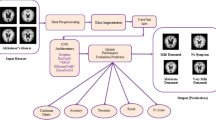Abstract
Alzheimer’s disease (AD) destroys memory and the ability to think in a rational way due to neurodegeneration. This degeneration is progressive as well as irreversible. It ultimately affects a person’s ability to do even trivial tasks. In this paper, we propose a neural predictor of AD from brain imaging done using magnetic resonance images (MRI) technology. Image classification networks like VGG, residual networks (ResNet), etc. with transfer learning show good results. These network architectures are taken and re-trained using brain images. It is shown that a deep ResNet neural architecture performs better in terms of accuracy. Kaggle dataset was used as the dataset to conduct our experiments.
Access this chapter
Tax calculation will be finalised at checkout
Purchases are for personal use only
Similar content being viewed by others
References
Patterson C (2018) The state of the art of dementia research: new frontiers. World Alzheimer Report
Meek PD, McKeithan EK, Schumock GT (1998) Economic considerations in Alzheimer’s disease. Pharmacotherapy J Hum Pharmacol Drug Ther 18(2P2):68–73
Dubois B et al (2014) Advancing research diagnostic criteria for Alzheimer’s disease: the IWG-2 criteria. Lancet Neurol 13(6):614–629
Huynh RA, Chandra M (2017) Alzheimer’s disease: biomarkers in the genome, blood, and cerebrospinal fluid. Front Neurol 8:102
Scheltens P et al (1992) Atrophy of medial temporal lobes on MRI in “probable” Alzheimer’s disease and normal ageing: diagnostic value and neuropsychological correlates. J Neurol Neurosurg Psychiatry 55(10):967–972
He K, Zhang X, Ren S, Sun J (2016) Deep residual learning for image recognition. In: 2016 IEEE conference on computer vision and pattern recognition (CVPR), Las Vegas, NV, pp 770–778. https://doi.org/10.1109/CVPR.2016.90
Eskildsen SF et al (2013) Prediction of Alzheimer’s disease in subjects with mild cognitive impairment from the ADNI cohort using patterns of cortical thinning. Neuroimage 65:511–521
Plant C et al (2010) Automated detection of brain atrophy patterns based on MRI for the prediction of Alzheimer’s disease. Neuroimage 50(1):162–174
Zhang D, Shen D (2012) Alzheimer’s disease neuroimaging initiative. Multi-modal multi-task learning for joint prediction of multiple regression and classification variables in Alzheimer’s disease. NeuroImage 59(2):895–907
Devanand DP et al (2012) MRI hippocampal and entorhinal cortex mapping in predicting conversion to Alzheimer’s disease. Neuroimage 60(3):1622–1629
Rathore S et al (2017) A review on neuroimaging-based classification studies and associated feature extraction methods for Alzheimer’s disease and its prodromal stages. NeuroImage 155:530–548
Plis SM et al (2014) Deep learning for neuroimaging: a validation study. Front Neurosci 8:229
Vieira S, Walter HLP, Mechelli A (2017) Using deep learning to investigate the neuroimaging correlates of psychiatric and neurological disorders: Methods and applications. Neurosci Biobehav Rev 74:58–75
Suk H-Il et al (2017) Deep ensemble learning of sparse regression models for brain disease diagnosis. Med Image Anal 37:101–113
Basaia S et al (2019) Automated classification of Alzheimer’s disease and mild cognitive impairment using a single MRI and deep neural networks. NeuroImage Clin 21:101645
Lin W et al (2018) Convolutional neural networks-based MRI image analysis for the Alzheimer’s disease prediction from mild cognitive impairment. Frontiers Neurosci 12:777
surfer.nmr.mgh.harvard.edu
Popuri K et al (2020) Using machine learning to quantify structural MRI neurodegeneration patterns of Alzheimer’s disease into dementia score: Independent validation on 8,834 images from ADNI, AIBL, OASIS, and MIRIAD databases. Hum Brain Mapp 41(14):4127–4147
Rallabandi VPS et al (2020) Automatic classification of cognitively normal, mild cognitive impairment and Alzheimer’s disease using structural MRI analysis. Inf Med Unlocked 100305
Liu M et al (2020) A multi-model deep convolutional neural network for automatic hippocampus segmentation and classification in Alzheimer’s disease. NeuroImage 208:116459
Dubey S (2019) Alzheimer’s dataset (4 class of images). https://www.kaggle.com/tourist55/alzheimers-dataset-4-class-of-images
Howard J, Gugger S (2020) Fastai: a layered API for deep learning. Information 11(2):108
Simonyan K, Andrew Z (2014) Very deep convolutional networks for large-scale image recognition. arXiv preprint arXiv:1409.1556
He K, Zhang X, Ren S, Sun J (2016) Deep residual learning for image recognition. In: 2016 IEEE conference on computer vision and pattern recognition (CVPR), pp 770–778. https://doi.org/10.1109/CVPR.2016.90
Author information
Authors and Affiliations
Corresponding author
Editor information
Editors and Affiliations
Rights and permissions
Copyright information
© 2022 The Author(s), under exclusive license to Springer Nature Singapore Pte Ltd.
About this chapter
Cite this chapter
Subramoniam, M., Aparna, T.R., Anurenjan, P.R., Sreeni, K.G. (2022). Deep Learning-Based Prediction of Alzheimer’s Disease from Magnetic Resonance Images. In: Saraswat, M., Sharma, H., Arya, K.V. (eds) Intelligent Vision in Healthcare. Studies in Autonomic, Data-driven and Industrial Computing. Springer, Singapore. https://doi.org/10.1007/978-981-16-7771-7_12
Download citation
DOI: https://doi.org/10.1007/978-981-16-7771-7_12
Published:
Publisher Name: Springer, Singapore
Print ISBN: 978-981-16-7770-0
Online ISBN: 978-981-16-7771-7
eBook Packages: Intelligent Technologies and RoboticsIntelligent Technologies and Robotics (R0)




